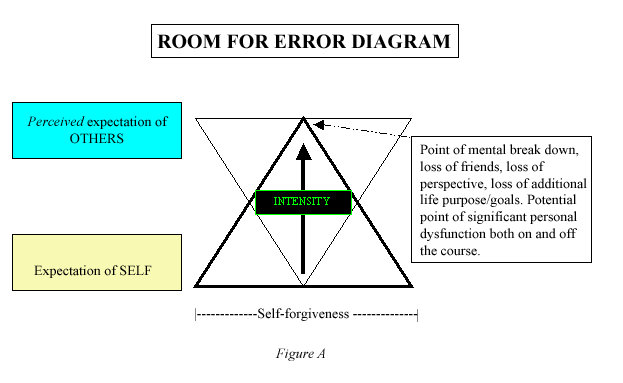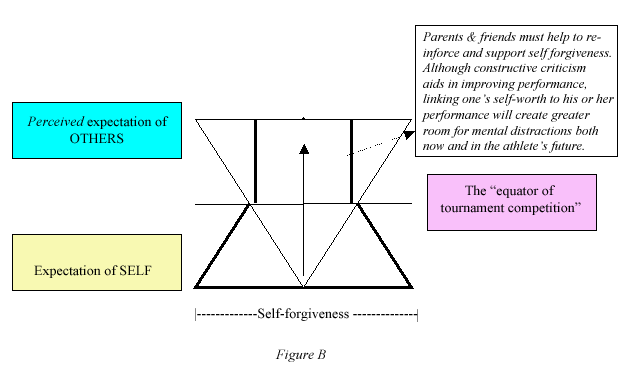| |
Defining Self in a World of Errors
An Athlete's Quest for Performance Perfection
Todd Monger, MA, LPC, NCC
Remember when playing was something we did for fun? When it
did not matter what the outcome was, as long as we had fun
doing it. Somewhere between needing something to do after
school and being accepted by others, the fun factor was diminished
by the competitive factor. While fun was still a core value
within competition, the real drive was to find value, purpose
and meaning in life by proving we were, or could be, better
than the next person.
Psychiatrist Erik Erickson, a prominent psychosocial developmental
theorist, postulated that personal development occurs by successfully
moving through eight social-emotional development stages or
crisis. Individuals who did not successfully navigate each
stage would result in a form of 'social retardation or stagnation.'
1. Infancy: Birth to 18 Months
Ego Development Outcome: Trust vs. Mistrust
Basic strength: Drive and Hope
2. Early Childhood: 18 Months to 3 Years
Ego Development Outcome: Autonomy vs. Shame
Basic Strengths: Self-control, Courage, and Will
3. Play Age: 3 to 5 Years
Ego Development Outcome: Initiative vs. Guilt
Basic Strength: Purpose
4. School Age: 6 to 12 Years
Ego Development Outcome: Industry vs. Inferiority
Basic Strengths: Method and Competence
5. Adolescence: 12 to 18 Years
Ego Development Outcome: Identity vs. Role Confusion
Basic Strengths: Devotion and Fidelity
Up to this stage, according to Erikson, development mostly
depends upon what is done to us. From here on out,
development depends primarily upon what we do. And
while adolescence is a stage at which we are neither a child
nor an adult, life is definitely getting more complex as we
attempt to find our own identity, struggle with social
interactions, and grapple with moral issues.
Our task is to discover who we are as individuals separate
from our family of origin and as members of a wider society.
Unfortunately for those around us, in this process many of
us go into a period of withdrawing from responsibilities,
which Erikson called a "moratorium." And if we are unsuccessful
in navigating this stage, we will experience role confusion
and upheaval.
A significant task for us is to establish a philosophy of
life and in this process we tend to think in terms of ideals,
which are conflict free, rather than reality, which is not.
The problem is that we don't have much experience and find
it easy to substitute ideals for experience. However, we can
also develop strong devotion to friends and causes.
It is no surprise that our most significant relationships
are with peer groups.
6. Young adulthood: 18 to 35
Ego Development Outcome: Intimacy and Solidarity vs. Isolation
Basic Strengths: Affiliation and Love
In the initial stage of being an adult we seek one or more
companions and love. As we try to find mutually satisfying
relationships, primarily through marriage and friends, we
generally also begin to start a family, though this age has
been pushed back for many couples who today don't start their
families until their late thirties. If negotiating this stage
is successful, we can experience intimacy on a deep
level.
If we're not successful, isolation and distance from
others may occur. And when we don't find it easy to create
satisfying relationships, our world can begin to shrink as,
in defense, we can feel superior to others.
Our significant relationships are with marital partners and
friends.
7. Middle Adulthood: 35 to 55 or 65
Ego Development Outcome: Generativity vs. Self absorption
or Stagnation
Basic Strengths: Production and Care
8. Late Adulthood: 55 or 65 to Death
Ego Development Outcome: Integrity vs. Despair
Basic Strengths: Wisdom
(Harder, 2002)
The "Room for Error Diagram" connects to this theory
in a way that suggests teenage athletes are facing more than
just skill development and mastery. In addition to being competitive
they are also seeking to define themselves, "be someone,"
find his or her niche in life. This can therefore be a set
up for increased pressure in the playing field, along with
creating greater psychological distraction, and contributing
to increased levels of frustration, anger and in turn physiological
reactions.
 |
|
DIVERSIFY YOUR INVESTMENT IN GOLF [your
sport] TO REDUCE FEAR OF FAILURE, THUS IMPROVING
FOCUS AND PERFORMANCE
|
|
 |
Explaining the "Room for Error Diagram"
Figure A
When people start out in a new sport it is often because
it looks fun, relaxing, enjoyable or is socially appealing.
At this stage, the athlete allows him or herself extensive
room for error. They are relaxed, non-confrontational,
forgiving of mistakes, and laugh at themselves. In contrast,
onlookers, friends, family and spectators show very little
interest or concern towards the performance of this individual.
The athlete does not feel the pressure of "expectations to
perform" because he or she is new to the game and are still
learning.
As time progresses the athlete begins to increase his or her
skill and ability moving them up the triangle illustrating
less forgiveness of mistakes. Friends, too, are increasing
their expectations such as golfing with a foursome and missing
a putt may result in "jeering, mocking or confrontation."
True competition begins where the two intersect; perhaps entering
into a club tournament or a game between friends where "stakes"
are on the line. Perceived room for error for the
athlete is lessening and expectations to perform are increasing.
The final stage is illustrated as the athlete progresses towards
less and less self forgiveness, and does not allow for personal
mistakes or errors within his or her performance. Onlookers
or "others" are also expecting far more at this stage. Asking
questions about why certain events happened, what the athlete
must have been thinking at the time, and making statements
about the athlete's performance or suggesting how to improve.
In teenage development, others may be parents, coaches
or friends who present these expectation dynamics. Heightened
expectations send messages to the adolescent that there is
no room for error and in turn the young competitor loses the
ability to forgive themselves. Such a dynamic will lead to
increased stress in competition, physiological reactions while
playing, and a person who is developing personal attributes
and coping mechanisms that are creeping into his or her everyday
life. The game is no longer "fun" it has become the object
by which the adolescent has, or is, defining themselves. To
lose, would be to fail - to fail as an athlete at this age
is to fail as a person - to fail as a person brings questions
about life in and of itself. Fun has become a thing
of the past, laughing is a fleeting moment. As Erikson stated,
this stage is no longer about what is done to us, but
rather value, importance, position and meaning in life is
about what we do [how we perform]. It truly
is the time by which identity or loss thereof [role
confusion, who am I? who am I to others?] is being defined
and shaped - a crisis. To function under the stress and growing
intensity of Figure A is to move towards a point of
mental collapse, emotional dysfunction and relational fall-out.
Figure B
Figure B is the adjusted diagram, one which seeks
to define a healthy way of competing at any stage in life.
Both figures start out the same, however, once the individual
crosses the "equator of tournament competition" a psychological
shift and commitment should be made.
Figure B demonstrates the important role friends, family
and coaches play in aiding an individual in having a balanced
outlook on his or her performance. While the triangle is definitely
constructed with less room for error at the competitor's stage,
it does not eliminate it entirely - nor is there a quest to
do so. Athletes should seek to keep the triangle open by positive
self talk and not linking one's performance with one's self-worth
and value. Others play a vital role in this stage too,
helping the athlete to maintain perspective, about the sport
and about life. Such perspective guards against the athlete
heading towards the point of break down within his
or her ego state.
No sport is a sport of perfect. If one could replicate performance,
competition would be redundant. To expect one's self to continually
perform at one's best, with no mistakes, is to set one's self
up to fail. There are too many variables in sport and performance
to not realize that one will make mistakes and commit errors.
Thus to perform well, an individual must be able to forgive
themselves and move on. Winning is often more about who can
recover the best from a mistake than it is about flawless
performance. The first step in recovery is to admit one's
mistake, forgive one's self and let it go.
Letting it go also lies within recognizing that there is more
to life than the task at hand - or even this sport altogether.
Figure A represents the fast track to defining one's
self by being the best as evidenced by no errors. Figure
B suggests that keeping a wide perspective to life, as
aided by others, to fail in competition is not the end of
the known world. Investment consultants will always advise
people to diversify one's stock so that if one investment
fails the others will cover the loss. Too often people define
themselves by the game they play, and when success is not
obtained their stock market crashes. [Unfortunately,
this sometimes applies to those who fall into the "others"
category as well, which is why they project so much pressure/expectation
onto the athlete to begin with].
Finally, it is also a diagram that seeks to prepare athletes
to be positioned well should a tragedy happen preventing them
from continuing on in his or her sport. Injury, loss of position
on a team [e.g. college] or age, may impact one's ability
to continue on in their sport. Those who are defined by it
as evidenced in Figure A have a much harder time seeing
other things in life that they can contribute to. Figure
B assists in helping athletes see the importance of keeping
options open in how much psychological investment that making
in defining themselves by their performance.
Conclusion
Performance perfection is an admirable goal and one which
keeps athletes training and applying themselves to the sport
they love. However, many athletes run the risk of being defined
by his or her sport, or feeling that they need to perform
at a certain level to contribute to this thing called life.
Many young athletes feel the need to win, or be the best,
for the perceived payoff in creating identity - being noticed
and being valued by parents, friends and spectators. Yet,
such efforts also run the risk of being enmeshed with the
adventure of competing, resulting in the losing of self and
the development of a high strung monster or washed
up recluse. While we each gain great satisfaction from
the games we play, let us seek to not lose focus on the reason
we began playing in the first place - remember when we used
to laugh?
Hardner, A. (2002) The Developmental Stages of Erik Erikson.
Retrieved January 23, 2007 from http://www.learningplaceonline.com/stages/organize/Erikson.htm
© Swing
Solutions, 2007
Todd Monger, MA, LPC, NCC currently serves as the
Head Golf Coach and director of the Student Success Center
at North Central University, in addition to providing
private consultation through Swing
Solutions. Todd is the creator of the innovative Vision
Instrument, a tool that visually assists athletes in identifying
why they are not psychologically performing at his or her
desired capacity. Originally from Australia, Todd is an excellent
communicator who currently resides in Minneapolis, MN. He
may be reached by email at
(Javascript required for email link)
Article Source: Todd Monger
Return to The
Mental Game of Learning and Skill Mastery Articles directory.
|
|